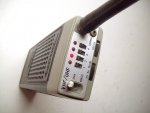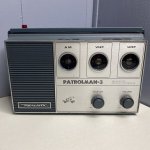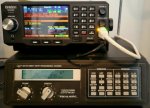First radio was a SEARS COM TREK 9 band in 1970. FD was on low band, but the radio did not perform well on low band. FD often not strong enough to break the squelch. We were in the river valley. Across the Potomac river was MD. Their PD was on high band, and the radio worked well for them, getting high signal strength meter readings and good squelch action. My PD had already gone to UHF by then, but this radio didn't do UHF. Or did it? I could see the Repeater site. One night, near 161 MHz, I heard a PD and confirmed it was mine. How? LO for 161 MHz = ~150 MHz, third harmonic = 450 MHz = LO for my 460 MHz PD! Sloppy that it worked that way, but it did! I learned a lot about radio from that radio that didn't work so well for me. Made me ask "Why?" or "Why not?" Always wanted one of those 'grand and glorious' multi-band tunable radios that picked up all three bands, moderately well at least, but never got one.
Next was a Patrolman 9 for the family move to IN. It was high band only for IN, 7 crystal controlled channels + an 8th tunable channel that could also be scanned. Actually got busted with that radio in my car at age 16! But things worked out Ok. My 'holding cell' was the conference room with a whole glass wall overlooking the Dispatch Center. Oh, hurt 16-year-old-me, interested in radio, some more!! Added a synthesizer to it in 1975.
From working at Radio Shack, I actually wound up working at the Regency scanner factory in 1978 on the Touch 16K first synthesized scanner. From there, Ham and Commercial FCC licenses. Then became a Navy pilot, call sign "Marconi" for all the radio, Morse Code, and frequency knowledge I took INTO the Navy with me. "Working" 225-400 MHz in AM mode was all business. Picked up PRO-2004 that picked up the military band, and the AOR-1000 hand held that also picked up the 225-400 MHz band in AM, and even wideband FM that could pick up the sonobuoys we dropped. Sea stories about how those radios both helped, and made senior officer suspicious of me and my radio capabilities.





